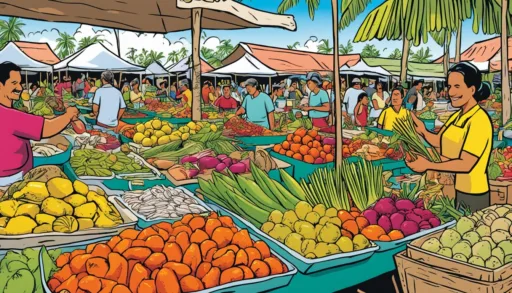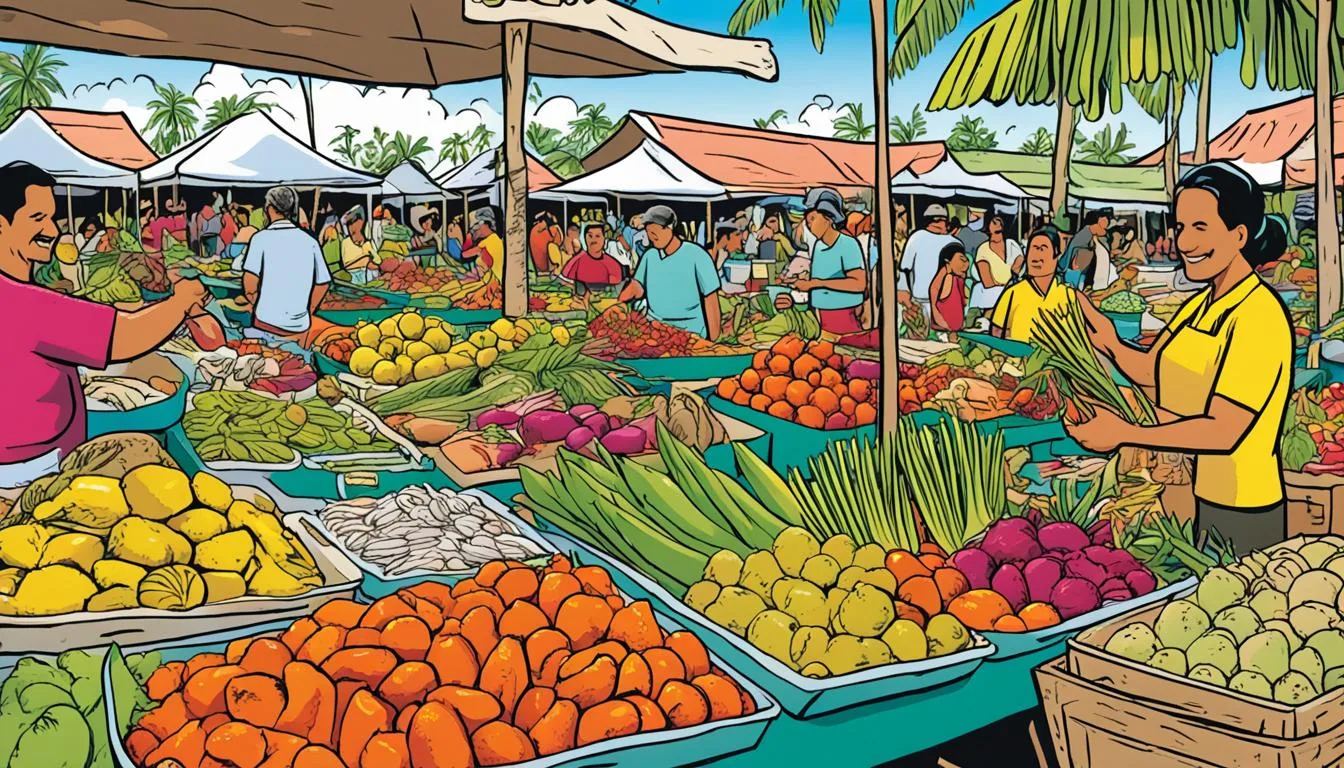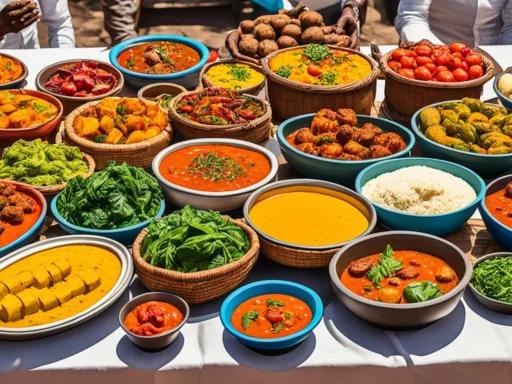Straddling the equator and sprawling across all four hemispheres, Kiribati may appear as a mere speck on the world map. However, this nation’s small size belies a culinary landscape as vast as the Pacific Ocean itself. Despite its compact land area of just 313 square miles, Kiribati offers a rich tapestry of taste, where traditional Kiribati dishes reveal a story of survival, innovation, and flavor. This archipelago’s food scene embodies a unique fusion of Micronesian heritage and oceanic bounty, inviting travelers on a distinctive Kiribati Food Journey to explore its unique flavors and culinary discovery.
Delving into the heart of Kiribati cuisine, one discovers a world where the Pacific Ocean gastronomy thrives upon an abundant supply of seafood, rivaled only by the ingenuity with which it is prepared. The gastronomic voyage across Kiribati’s trove of atolls is a testament to the character of its people, who have gracefully adapted to their environment, creating a selection of dishes that beckon with their simplicity and sincerity.
Key Takeaways
- Embark on a Kiribati Food Journey that spans across all hemispheres of our planet.
- Delve into the heart of Kiribati cuisine, embracing the delicacies shaped by the Pacific Ocean.
- Discover the traditional Kiribati dishes that highlight the innovation and resilience of the island’s culture.
- Experience the unique flavors and culinary discovery offered by Kiribati’s rich and diverse food scene.
- Immerse yourself in the world of Pacific Ocean gastronomy, where the daily harvest meets timeless cooking traditions.
Unveiling Kiribati: A Hidden Culinary Gem in the Pacific
Amidst the vast blue waters of the Pacific Ocean, one finds the scattered emeralds of the Kiribati archipelago. This cluster of islands provides a plethora of flavors and traditional dishes that form the unique and historical Kiribati food culture. Known for its rich Pacific Ocean cuisine, Kiribati’s culinary identity is shaped by both tradition and the bounty provided by its surrounding waters.
An Introduction to the Kiribati Archipelago
With its enchanting spectrum of atolls, Kiribati stands as a testament to the splendor of equatorial delights. The island nation consists of the Gilbert, Phoenix, and Line islands, among which the Kiritimati or Christmas Island reigns as the largest atoll, offering an unmatched cultural tapestry through its cuisines.
Geographic Influence on Kiribati’s Culinary Scene
From the geographical mosaic come the culinary gems that form the backbone of the local diet. Seafood is not just sustenance but a way of life, with the renowned “grey ghosts” or bonefish being a prime example. Equipped with an assortment of home-grown flavors, Kiribati chefs create dishes that are both aromatic and wholesome, underscoring the geographic influences of their food. The Captain Cook Hotel is just one such place where visitors can immerse themselves in the genuine flavors of local cuisine, nestled in charming thatched bungalows.
| Culinary Element | Description | Significance |
|---|---|---|
| Bonefish (Grey Ghosts) | Renowned game fish locally consumed | A symbol of the bountiful Kiribati waters |
| Copra | Dried meat of coconuts used in various dishes | Reflects the versatile use of coconuts in Kiribati cuisine |
| Land Crabs | Abundant in the islands, served as a delicacy | Represents Kiribati’s reliance on terrestrial and marine fauna |
Exploring the Kiribati archipelago proves to be an enlightening encounter with not just the calming vistas of the Pacific but also with an array of culinary gems. Offering a slice of Pacific perfection, the cuisine speaks of the nation’s heritage, a harmonious blend of sea whispers and equatorial generosity. Welcome to Kiribati, where each dish is a story of the island’s heart and history.
Exploring the Flavors of Kiribati: Traditional Dishes and Ingredients
Embark on a culinary exploration that dives into the heart of the Pacific, where the traditional dishes of Kiribati tell a tale of the ocean’s bounty and the ingenuity of its people. Using seafood cuisine, fresh ingredients, and local produce, the Kiribati recipes captivate with simplicity and freshness.
The Role of Seafood in Kiribati Recipes
Surrounded by the vast Pacific Ocean, Kiribati revels in a variety of seafood that anchors its culinary heritage. From the prized bonefish to the succulent meat of land crabs, each dish reflects a deep connection with the sea. With each bite of these traditional Kiribati dishes, one can taste the essence of the islands’ seafood cuisine—a testimony to their rich marine surroundings.
Local Produce: Beyond Sea Harvests
While Kiribati cuisine is synonymous with seafood, the use of local produce adds color and depth to its gastronomy. Farmers on these coral atolls cultivate what the land can support, including breadfruit, coconuts, and taro. In Kiribati recipes, such fresh ingredients are skillfully combined to create a harmonious blend of flavors that symbolize the resilient spirit of the I-Kiribati people.
| Ingredient | Role in Kiribati Cuisine | Traditional Dish Examples |
|---|---|---|
| Coconut | Base for sauces and broths | Palusami, Te Bua Toru |
| Seafood | Main protein source | Grilled fish, Crab soup |
| Taro | Staple root vegetable | Taro porridge, Babai |
| Papaya | Sweet fruit balance | Raw Papaya Salad, Marinated Fish with Papaya |
| Pandanus | Flavoring for sweets and teas | Pandanus cake, Pandanus tea |
The Cultural Tapestry of Kiribati Cuisine
The islands of Kiribati are not just a spectacular panorama of the Pacific but a realm where culinary history and cultural diversity intermingle. Kiribati gastronomy, with a narrative as rich as its flavors, beckons a gastronomical exploration unlike any other. Once a British protectorate, Kiribati’s culinary tapestry is colored by the imprints left by its colonial past, the indigenous Micronesian influence, and the threads of modern international infusion.
Kiribati’s independence in 1979 was a pivotal moment for its cuisine as it began weaving new patterns into its cultural tapestry. The local fare encapsulates authentic Kiribati flavors that have been sustained through years of cooking traditions, revolving around communal ties and the profound respect for natural bounty.
History’s Imprint on Today’s Kiribati Gastronomy
Each dish served within the islands is a reminder of the Kiribati’s journey through time. The culinary history of Kiribati is etched into every bite, from the staple babai (a root crop similar to taro) to the revered dishes reserved for special ceremonies. International influences are now interlaced with traditional methods, creating a culinary identity that is inherently Kiribati yet globally enriched. Global interactions have introduced new ingredients and cooking styles, which have been adapted to fit into the I-Kiribati way of life.
Micronesian Influences on Kiribati’s Culinary Identity
The Micronesian influence is poignantly observed in the I-Kiribati’s reverence for the ocean. Fishing isn’t merely an activity but an artistry that has transcended generations, contributing essential elements to Kiribati’s dining ritual. There is a certain art in the simplicity of grilling freshly caught fish over an open flame and serving it with a side of coconut-infused rice or pandanus fruit.
The ceremonial foods such as te bwabwai—fermented breadfruit or taro buried and baked in pits beneath the ground—continue to be a fundamental component of Kiribati’s celebrations, reflecting the Micronesian heritage deeply embedded in the islands’ societal fabric.
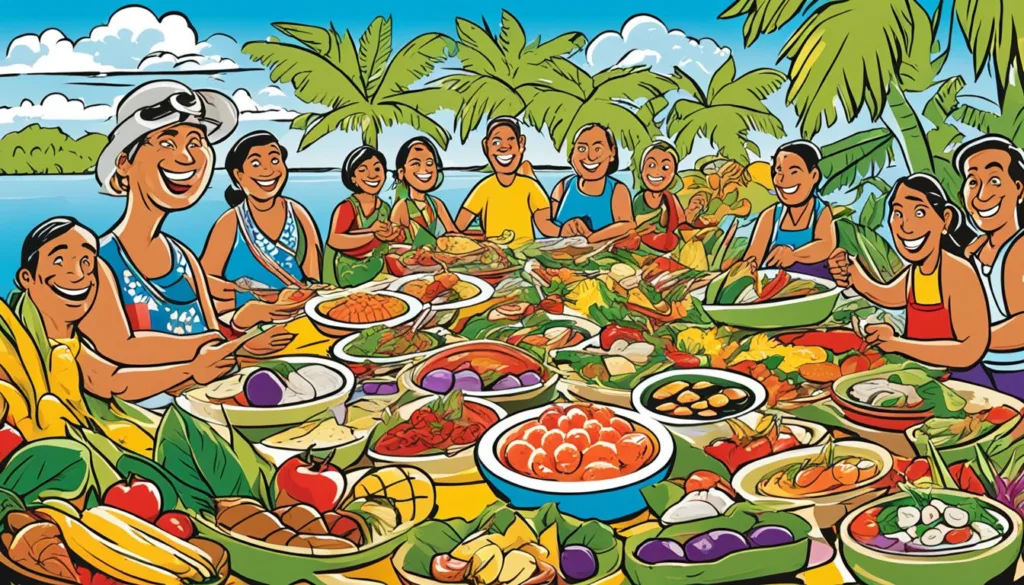
The I-Kiribati language and Christianity have also permeated the collective gustatory consciousness, adding both lexical and spiritual dimensions to the islands’ gastronomic profile. Furthermore, historical tumults, such as the Japanese occupation during World War II, have left an indelible mark on Kiribati’s cultural and edible landscape. Today, these influences are deftly folded into the everyday life and festive customs, honoring the past while savoring the present.
Through these layers of historical and cultural significance, the culinary narrative of Kiribati speaks volumes of its resilience and adaptability. The authentic flavors of Kiribati are an ode to a time-honored lifestyle, a testament to the islands’ enduring spirit, and an invitation to the world to discover the richness interwoven within its remarkable cooking traditions.
Kiribati Food Journey: From Ocean to Table
Embark on a tantalizing Kiribati culinary experience, where the essence of ocean-to-table eating is celebrated through the island’s daily harvest. Imagine sitting on the shore, the scent of the sea mingling with that of cooking fires, as you prepare for a flavorful adventure featuring the day’s freshest seafood. This culinary journey is not just about sustenance but about a deep connection with the ocean’s gifts, serving up authentic Kiribati cuisine that captivates with its purity and oceanic flavors.
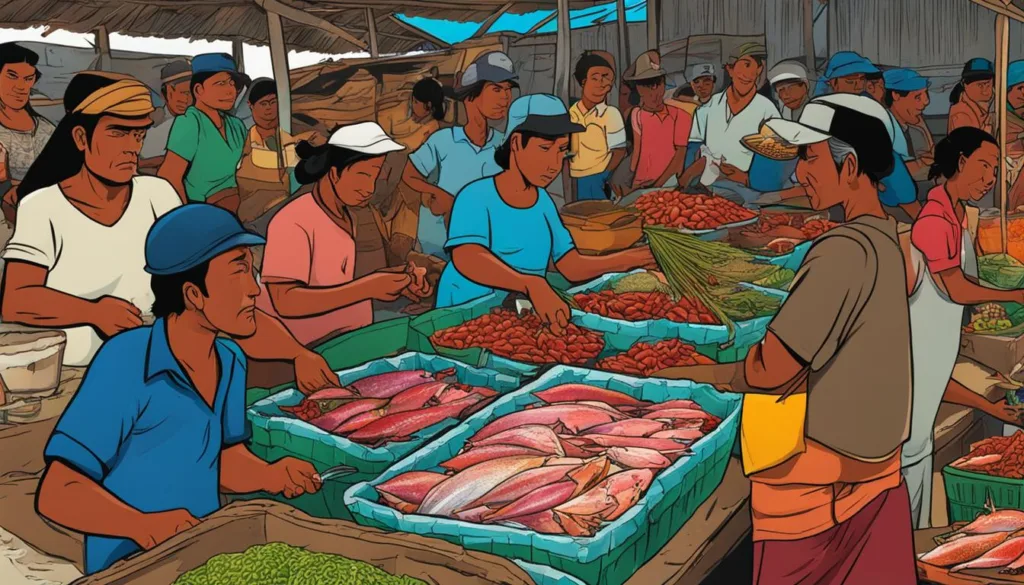
As you sample the array of seafood, each dish tells its own story of the journey from sea to the table. The local fisherfolk, experts in harnessing the riches of the Pacific, take pride in their sustainable practices, ensuring that each fish, from the robust tuna to the sleek wahoo (ono), is a testament to the health of their aquatic terrains. An exploration of giant trevally among the local catches will reveal the dedication to quality and freshness that defines the ocean-to-table ethos in Kiribati.
| Seafood Delicacy | Description | Preparation Style |
|---|---|---|
| Tuna | Ruby-red and rich in flavor | Grilled and seasoned with local spices |
| Wahoo (Ono) | Firm texture with a mild, sweet taste | Served as ceviche, infused with lime and coconut |
| Giant Trevally | Powerful flavor, perfect for hearty meals | Braised with pandanus leaves for a unique aroma |
To experience the authentic Kiribati cuisine is to understand the islanders’ reverence for their maritime environment. The simplicity of their cooking methods enhances the natural essence of the fresh seafood, turning every meal into a celebration of the island’s bountiful oceanic flavors. This culinary journey doesn’t just feed the body; it nourishes the soul with tastes that encapsulate the spirit of Kiribati.
Sustainable Harvesting: Kiribati’s Approach to Seafood
Kiribati, a nation known for its bountiful oceans and rich traditions, is on the forefront of sustainable harvesting, cementing its commitment to marine conservation. The ethos of Kiribati seafood is firmly rooted in preserving the abundant marine life that is both a source of sustenance and cultural heritage to the island’s inhabitants. Emphasizing the relationship between people and their environment, Kiribati sets a benchmark for culinary sustainability and marine life preservation.

Conserving Marine Life for Future Generations
The protection of diverse species is imperative for Kiribati as its waters are home to a variety of marine creatures including the vibrant red land crabs and myriad fish species. The importance placed on maintaining balance within the ecosystem ensures that future generations can continue to enjoy and depend on these resources, just as their ancestors have for centuries.
Traditional Fishing Techniques and Sustainability
Integrating traditional fishing techniques that have minimal negative impact on marine habitats stands as testimony to the I-Kiribati’s enduring respect for nature’s ingenuity. Techniques such as hand-lining showcase a harmonious technique that aligns with the principles of sustainability, ensuring that fishing practices do not deplete the ocean’s bounty.
| Sustainable Technique | Benefits | Impact on Marine Life |
|---|---|---|
| Hand-lining | Selective and low bycatch rates | Preserves fish populations and habitats |
| Moon Calendar Fishing | Adheres to natural breeding cycles | Supports natural regeneration |
| Closed Seasons/ Areas | Allows for recovery and spawning | Boosts marine biodiversity |
The conscientious approach undertaken by Kiribati not only preserves the delicate balance of marine ecosystems but also serves as a model for global practices in fisheries and oceanic stewardship. By valuing traditional methods and advocating for responsible consumption, Kiribati leads by example, inspiring a future where marine resources flourish and culinary traditions remain intact for the enjoyment of all.
The Heart of Kiribati Cooking: Traditional Cooking Methods
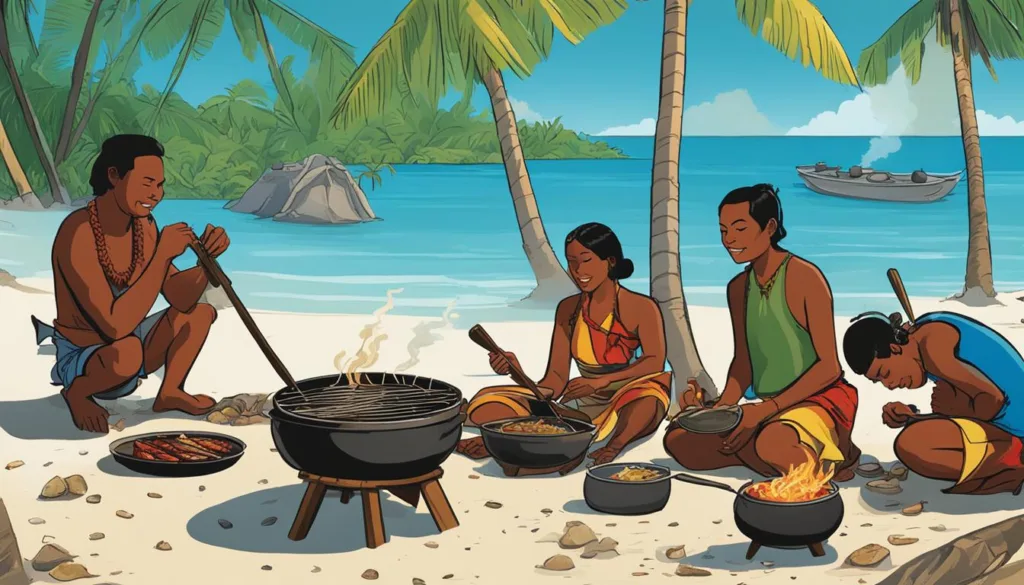
Exploring the Kiribati culinary arts reveals a world where authentic cooking practices are cherished and preserved. Renowned for its culinary heritage, Kiribati’s approach to cuisine is a celebration of both the bountiful blessings of the Pacific and the ingenuity of its people. Central to this celebration are the traditional cooking methods that have been honed over centuries.
- Open Flame Cooking: A testament to the time-honored technique where meals are prepared over a fire, bestowing a unique smoky flavor.
- Earth Ovens: Known locally as ‘um’, this traditional method involves cooking food wrapped in leaves in a pit filled with hot rocks, yielding tender and aromatic dishes.
- Communal Preparations: Emphasizing community and collaboration, food preparation often becomes a unifying social event.
Immersing oneself in Kiribati cooking traditions offers an intimate glimpse into the soul of the Pacific. These cooking techniques do more than just nourish; they carry stories and a legacy reflective of the resourcefulness and resilience of Kiribatian culture.
Rooted in tradition, Kiribati’s authentic approach to food preparation serves as a living link between the past and present, allowing each dish to resonate with the spirit of the islands.
Kiribati on the Festive Table: Celebratory and Ceremonial Foods
Each year, islands scattered across the Pacific Ocean burst into a spectrum of color and flavor as Kiribati festivities light up the social calendar. The culinary landscape of this vibrant nation is forged not only in day-to-day sustenance but also in the rich tapestry of celebratory foods that make festive occasions truly memorable. Kiribati communal dining becomes a tableau of unity and joy, embodying the islands’ spirit during celebrations that reverberate with spiritual significance.
Feasts and Festivities: A Look at Communal Dining
In the heart of the Pacific, amidst the lapping waves and swaying palms, communal feasts serve as an expressive canvas for Kiribati’s societal bonds. Tables laden with ceremonial cuisine mark milestones from weddings to national holidays, where ritualistic foods such as te babai, a savory pudding made of mashed giant swamp taro, take center stage. These gatherings are not merely about eating; they represent a collective culinary embrace, one where recipes passed down through generations find new life in every shared meal.
Spiritual and Ritualistic Significance in Kiribati Cuisine
The spiritual tapestry of Kiribati cuisine is woven from threads of ancestral beliefs and Christian faith, blended harmoniously on plates that hold more than food – they cradle heritage. Celebratory foods intertwined with ritualistic practices showcase the depth of the I-Kiribati’s connection to their past. For instance, the first catch of a fishing voyage, dedicated to ancestors for blessings, exemplifies the intertwining of sustenance and spirituality, reflecting the profound cultural and ceremonial dimensions embedded in the act of communal dining.
| Festival | Main Dish | Spiritual Significance |
|---|---|---|
| Independence Day | Grilled fish and breadfruit | Celebration of freedom and a nod to traditional sustenance |
| Christmas | Reef fish cooked in coconut cream | Christian influences merging with island flavors |
| New Year | Feast of pork and rice dishes | Welcoming prosperity for the coming year |
| Youth Day | Various seafood in pandanus leaf wraps | Passing down culinary legacies to the next generation |
Thus, Kiribati’s ceremonial feasts and the daily act of breaking bread are rich not only in flavors but in the stories they tell and the legacies they uphold. The I-Kiribati culinary scene is a feast for the senses, an effervescent celebration of life’s ebbs and flows through the shared enjoyment of ritualistic foods, each with its own tale to tell.
Sampling Kiribati: A Guide to Local Eateries and Street Food
Embarking on a Kiribati eateries guide is akin to setting sail on a culinary adventure across the Pacific, where the treasure trove of authentic Kiribati flavors await the intrepid foodie. The bustling streets and tranquil beaches of Kiribati serve as the backdrop for a local dining experience that tantalizes the senses. The archipelago’s vibrant foodie destinations are steeped in the traditions and tastes of the islands, offering a rare glimpse into the heart of Kiribati gastronomy.
Where to Find Authentic Kiribati Flavors
For those hungering for true Kiribati cuisine, look no further than the thatched-roof huts where sizzling grills lay out local catches, and modest family-run eateries dot the coastlines. Each local establishment, a doorway to the soul of the islands, promises an unparalleled taste of the nation’s heritage, with dishes rich in coconut milk and an abundance of fresh seafood.
Eating Like a Local: Kiribati Street Food Experiences
No street food journey in Kiribati is complete without indulging in the fresh flavors offered by street-side vendors. As the sun sets, the aroma of grilled fish fills the air, beckoning passersby to participate in an age-old island feast. Here, amidst the warm company and under the star-lit sky, visitors find more than nourishment; they find a connection to the simple, yet profound pleasures of I-Kiribati life.
Home Cooking in Kiribati: Recipes to Try
Immerse yourself in the vibrant home cooking in Kiribati, where every dish narrates the serene simplicity and rich culinary traditions of this beautiful island nation. In the comfort of your own kitchen, you can recreate a variety of Kiribati recipes that bring the balmy Pacific breeze and the warmth of the sun into your home. Fans of fresh, homemade dishes will fall in love with the uncomplicated yet flavorsome characteristics of traditional Kiribati cooking.
Kiribati cuisine relies heavily on the bounties of the sea, making it a unique treasure trove of island cuisine. To help you explore these flavors, we’ve selected a few traditional recipes that celebrate local seafood and produce. The following dishes represent a slice of life on the Kiribati Islands and are sure to enchant your culinary senses.
- Grilled Fresh Fish: Simply seasoned with salt, pepper, and a squeeze of lime, grilled over an open flame to perfection.
- Banana and Coconut Milk: Ripe bananas simmered gently in rich, sweet coconut milk, a heavenly dessert or a comforting snack.
- Palu Sami: A delightful concoction of taro leaves, onion, and fresh coconut cream wrapped in banana leaves and baked to create a succulent savory treat.
Adopting the principles of traditional Kiribati cooking is not only about following recipes; it’s about embracing an ethos where fresh, wholesome ingredients take center stage, and meals are prepared with love and care. Whether you’re a seasoned chef or a curious foodie, these dishes offer a window into the heart of Kiribati and its enduring relationship with nature’s gifts.
Bring a taste of Kiribati to your table and celebrate the unpretentious yet profound joy of creating delectable homemade dishes that resonate with the harmonious island life of this Pacific paradise.
The Culinary Future of Kiribati: Preserving Tradition in a Changing World
Amidst the rising tides of modernization and global culinary trends, the Republic of Kiribati stands at a culinary crossroads. Striving to embrace the future while holding fast to its rich gastronomic past, the island nation is engaging in a delicate dance of preserving traditions against the vibrant backdrop of contemporary Kiribati cuisine.
Challenges and Creativity in Modern Kiribati Cooking
The culinary heritage of Kiribati faces an array of modern challenges, from the impacts of climate change on local agriculture to the influx of Western food habits. Yet in these challenges lie opportunities for creative cooking, where enterprising chefs and home cooks are blending ancestral techniques with global flavors, crafting dishes that honor Kiribati’s traditions while looking to the culinary future.
Adventurous reinterpretations of classics, such as the use of locally sourced seaweed in inventive salads or the incorporation of fresh catches in fusion dishes, showcase the potential evolution of Kiribati’s cuisine while maintaining the integrity of its origins. This resurgence of interest in local, sustainable ingredients is a heartening sign of the culinary resilience that defines Kiribatians.
Fostering Culinary Heritage Among Young Kiribatians
The passage of culinary wisdom is a cornerstone of Kiribati culture, and much emphasis is placed on encouraging young Kiribatians to take up the mantles of their forebears. Special cooking classes, family-run cooking sessions, and community programs are designed to ignite passion for traditional practices in the youth, securing a place for the nation’s flavourful legacy in the kitchens of future generations.
By supporting these young culinarians and creating platforms for them to display their culinary explorations, Kiribati is investing in not just the preservation, but the renewal of its culture. This commitment permits the archipelago’s tastes and traditions to persist and evolve, promising a dynamic culinary future for Kiribati.
Conclusion
As we wrap up this culinary odyssey, let’s hold a moment to appreciate the unique heritage of Kiribati, an archipelago where the ocean’s bounty meets the ingenuity of traditional cooking. A journey to discover Kiribati cuisine is not only an excursion of taste but also a venture into the heart of Pacific Ocean gastronomy. To travel and taste this nation’s dishes is to partake in a story of people, their history, and the kaleidoscopic flavors that define their culture.
Invitation to Discover and Protect Kiribati’s Culinary Richness
The culinary preservation of Kiribati’s gastronomic offerings is a shared charge for those who cherish both the food and the narratives it carries. We are invited to not merely sample, but to nurture the culinary richness of Kiribati, ensuring its authenticity endures for future voyagers. Through respectful engagement and responsible tourism, every traveler can contribute to the survival of this Pacific culinary gem.
Embarking on Your Own Kiribati Food Adventure
Whether you’re a seasoned epicure or a curious foodie, embarking on a food adventure in Kiribati promises an unrivaled encounter with its traditional delights and modern renditions. The diverse array of Kiribati culinary experiences awaits those bold enough to immerse themselves in its robust and delicate tastes. So, ready your palate, set sail for the islands, and immerse yourself in the sensory richness that is Kiribati’s cuisine. Every bite, a step closer to understanding the essence of life on these magnificent atolls.
FAQ
What is so unique about Kiribati cuisine?
Kiribati cuisine is unique due to its reliance on fresh seafood and coconut, which are abundant in the islands. Its geographical isolation also means that traditional dishes have developed over time, largely uninfluenced by outside cuisines, resulting in a distinct blend of flavors and cooking techniques.
What are some traditional Kiribati dishes to try?
Traditional Kiribati dishes worth trying include palu sami (a taro leaf and coconut milk dish), sashimi, grilled seafood, babai (a giant swamp taro root crop), and various fish dishes like tuna and wahoo, often prepared with coconut.
How do the islands’ geography and history influence Kiribati’s food culture?
Kiribati’s food culture is shaped by its location in the Pacific Ocean, which provides an abundance of seafood. The country’s history as a British protectorate and its Micronesian ancestry have introduced various cultural and culinary influences that enrich its gastronomy.
Are there any local customs around food that travelers should be aware of?
Yes, communal dining is a significant part of Kiribati culture, and sharing food is a sign of hospitality and friendship. Visitors should be respectful of local customs, such as waiting to be invited to eat and showing gratitude for the food shared with them.
Can you find international cuisine in Kiribati?
While traditional Kiribati dishes are predominant, international cuisine, including Chinese and Western influences, can be found, particularly in urban areas like Tarawa.
How do Kiribati local eateries contribute to the food experience?
Local eateries in Kiribati offer an intimate look into the daily life and food culture of the islanders. They provide authentic and freshly prepared meals that are true to traditional recipes and cooking methods.
Do Kiribati foods have any health benefits?
Yes, many Kiribati dishes are rich in nutrients from fresh seafood, which is high in protein and omega-3 fatty acids, and from local fruits and vegetables. The cuisine tends to be natural and minimally processed, contributing to its health benefits.
How does Kiribati address sustainability in its food practices?
Kiribati promotes sustainable food practices by maintaining traditional fishing techniques, such as hand-lining, which have minimal environmental impact. The country also works on protecting its marine habitats to ensure the longevity of its food sources.
What can travelers do to respect Kiribati’s food culture?
Travelers can respect Kiribati’s food culture by showing appreciation for local ingredients and dishes, participating in traditional dining customs, and supporting sustainable practices by dining at establishments that prioritize ecological balance.
How can I learn about Kiribati cooking traditions?
To learn about Kiribati cooking traditions, visitors can engage with locals, participate in food-related activities such as fishing or cooking classes, and explore various traditional recipes that showcase the nation’s culinary heritage.
